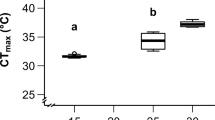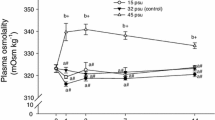Abstract
Antarctic fish, such as the Trematomus bernacchii, living at −1.9°C maintain a serum osmolality of around 600 mOsm kg−1, nearly twice that of temperate fish. Upon warm acclimation, Antarctic fish significantly lower their serum osmolality. It has been suggested that this response to warm acclimation is due to stress. The purpose of this study was to determine, whether upon warm acclimation there was a change in the levels of the stress hormone cortisol and hematocrit associated with the decrease in serum osmolality. T. bernacchii were warm acclimated up to 4 weeks and serum osmolality, cortisol and hematocrit were measured. Upon warm acclimation to +1.6 and +3.8°C over the course of 4 weeks, T. bernacchii significantly lowered their serum osmolality (from 547 ± 4 mOsm kg−1 to 494 ± 6 and 489 ± 4 mOsm kg−1, respectively), yet did not alter their serum cortisol (29 ± 6 nl ml−1) or hematocrit (22 ± 1%) levels. These results suggest that warm acclimation does not induce a stress response in T. bernacchii.



Similar content being viewed by others
References
Abo Hegab S, Hanke W (1984) The significance of cortisol for osmoregulation in carp (Cyprinus carpio) and tilapia (Sarotherodon mossambicus). Gen Comp Endocrinol 54:409–417
Balm PH, Lambert JD, Wendelaar Bonga SE (1989) Corticosteroid biosynthesis in the interrenal cells of the teleost fish, Oreochromis mossambicus. Gen Comp Endocrinol 76:53–62
Barton BA (2002) Stress in fishes: A diversity of responses with particular reference to changes in circulating corticosteroids. Integr Comp Biol 42:517–525
Brauer PR, Sanmann JN, Petzel DH (2005) Effects of warm acclimation on Na+, K+-ATPase alpha-subunit expression in chloride cells of Antarctic fish. Anat Rec A Discov Mol Cell Evol Biol 285:600–609
Chrousos GP (1998) Stressors, stress, and neuroendocrine integration of the adaptive response. The 1997 Hans Selye Memorial Lecture. Ann NY Acad Sci 851:311–335
Dang Z, Balm PH, Flik G, Wendelaar Bonga SE, Lock RA (2000) Cortisol increases Na(+)/K(+)-ATPase density in plasma membranes of gill chloride cells in the freshwater tilapia Oreochromis mossambicus. J Exp Biol 203:2349–2355
Davis KB (1984) Biotic and abiotic influences on corticosteroid hormone rhythms in Channel Catfish. Trans Am Fish Soc 113:414–421
Davison W, Franklin CE, McKenzie JC (1994) Haematological changes in an Antarctic teleost, Trematomus bernacchii, following stress. Polar Biol 14:463–466
De Boeck G, Vlaeminck A, Balm PH, Lock RA, De Wachter B, Blust R (2001) Morphological and metabolic changes in common carp, Cyprinus carpio, during short-term copper exposure: interactions between Cu2+ and plasma cortisol elevation. Environ Toxicol Chem 20:374–381
Deane EE, Kelly SP, Woo NY (2000) Hypercortisolemia does not affect the branchial osmoregulatory responses of the marine teleost Sparus sarba. Life Sci 66:1435–1444
DeVries AL, Komatsu SK, Feeney RE (1970) Chemical and physical properties of freezing point-depressing glycoproteins from Antarctic fishes. J Biol Chem 245:2901–2908
Dobbs GH, DeVries AL (1975) Renal function in Antarctic teleost fishes: serum and urine composition. Mar Biol 29:5–70
Egginton S, Davison B (1998) Effects of environmental and experimental stress on Antarctic fish In: Portner, Playle (eds) Cold ocean physiology, Cambridge University Press, Cambridge, pp 299–326
Evans D, Piermarini PM, Choe KP (2005) The multifunctional fish gill: dominant site of gas exchange, osmoregulation, acid–ase regulation, and excretion of nitrogenous waste. Physiol Rev 85:97–177
Forster ME, Davison W, Axelsson M, Sundin L, Franklin CE, Gieseg S (1998) Catecholamine release in heat-stressed Antarctic fish causes proton extrusion by the red cells. J Comp Physiol [B] 168:345–352
Foskett JK, Bern HA, Machen TE, Conner M (1983) Chloride cells and the hormonal control of teleost fish osmoregulation. J Exp Biol 106:255–281
Franklin CE, Davidson W, Carey PW (1991) The stress response of an Antarctic teleost to an acute increase in temperature. J Therm Biol 16:173–177
Fuentes J, Bury NR, Carroll S, Eddy FB (1996) Drinking in Atlantic salmon presmolts (Salmo salar L.) and juvenile rainbow trout (Oncorhynchus mykiss Walbaum) in response to cortisol and sea water challenge. Aquaculture 141:129–137
Gamperl A, Vijayan M, Boutilier R (1994) Experimental control of stress hormone levels in fishes: techniques and applications. Rev Fish Biol 4:215–255
Gonzalez-Cabrera PJ, Dowd F, Pedibhotla VK, Rosario R, Stanley-Samuelson D,Petzel D (1995) Enhanced hypo-osmoregulation induced by warm-acclimation in antarctic fish is mediated by increased gill and kidney Na+/K(+)-ATPase activities. J Exp Biol 198:2279–2291
Guynn S, Dowd F, Petzel D (2002) Characterization of gill Na/K-ATPase activity and ouabain binding in Antarctic and New Zealand nototheniid fishes. Comp Biochem Physiol A Mol Integr Physiol 131:363–374
Jiang JQ, Young G, Kobayashi T, Nagahama Y (1998) Eel (Anguilla japonica) testis 11beta-hydroxylase gene is expressed in interrenal tissue and its product lacks aldosterone synthesizing activity. Mol Cell Endocrinol 146:207–211
Jin Y, DeVries AL (2006) Antifreeze glycoprotein levels in Antarctic notothenioid fishes inhabiting different thermal environments and the effect of warm acclimation. Comp Biochem Physiol B 144:290–300
Laiz-Carrion R, Martin Del Rio MP, Miguez JM, Mancera JM, Soengas JL (2003) Influence of cortisol on osmoregulation and energy metabolism in gilthead seabream Sparus aurata. J Exp Zoolog A Comp Exp Biol 298:105–118
Lowe CJ, Davison W (2005) Plasma osmolality, glucose concentration and erythrocyte responses of two Antarctic nototheniid fishes to acute and chronic thermal change. J Fish Biol 67:752–766
Lowe TE, Wells RMG (1997) Excercise challenge in Antarctic fish: do haematology and muscle metabolite levels limit swimming performance? Polar Biol 17:211–218
Lyytikainen T, Pylkko P, Ritola O, Lindstrom-Seppa P (2002) The effect of acute stress and temperature on plasma cortisol and ion concentrations and growth of Lake Inari Arctic charr, Salvelinus alpinus. Environ Biol Fishes 64:195–202
Madsen SS, Jensen MK, Nhr J, Kristiansen K (1995) Expression of Na(+)-K(+)-ATPase in the brown trout, Salmo trutta: in vivo modulation by hormones and seawater. Am J Physiol 269:R1339–1345
McCormick SD (1995) Hormonal control of gill Na+, K+-ATPase and chloride cell function In Fish Physiology 14:285–315
Morrison JF, Guynn SR, Scofield MA, Dowd FJ, Petzel DH (2006) Warm acclimation changes the expression of the Na+, K+-ATPase alpha subunit isoforms in Antarctic fish gills. J Exp Mar Biol Ecol 333:129–139
O’Grady SM, DeVries AL (1982) Osmotic and ionic regulation in polar fishes. J Exp Mar Biol Ecol 57:219–228
Petzel D (2005) Drinking in Antarctic fishes. Polar Biol 28:763–768
Prunet P, Sturm A, Milla S (2006) Multiple corticosteroid receptors in fish: From old ideas to new concepts. Gen Comp Endo 147:17–23
Redding JM, Schreck CB (1983) Influence of ambient salinity on osmoregulation and cortisol concentration in yearling coho salmon during stress. Trans Am Fish Soc 112:800–807
Rotllant J, Balm PH, Wendelaar Bonga SE, Perez-Sanchez J, Tort L (2000) A drop in ambient temperature results in a transient reduction of interrenal ACTH responsiveness in the gilthead sea bream (Sparus aurata, L.). Fish Physiol Biochem 23:265–273
Ryan SN (1995) The effect of chronic heat stress on cortisol levels in the Antarctic fish Pagothenia borchgrevinki. Experientia 51:768–774
Sangalang GB, Uthe JF (1994) Corticosteroid activity, in vitro, in interrenal tissue of Atlantic salmon (Salmo salar) parr. 1. Synthetic profiles. Gen Comp Endocrinol 95:273–285
Schmidt-Nielson K (1997) Animal physiology: adaptation and environment. Cambridge University Press, Cambridge
Seebacher F, Davison W, Lowe C, Franklin C (2005) A falsification of the thermal specialization paradigm: compensation for elevated temperatures in Antarctic fishes. Biol Lett 1:151–154
Somero GN, DeVries AL (1967) Temperature tolerance of some Antarctic fishes. Science 156:257–258
Staurnes M, Rainuzzo JR, Sigholt T, Jorgensen L (1994) Acclimation of Atlantic cod (Gadus morhua) to cold water : stress response, osmoregulation, gill lipid composition and gill Na, K-ATPase activity. Comp Biochem Physiol A 109:413–421
Strange RJ (1980) Acclimation temperature influences cortisol and glucose concentrations in stressed channel catfish. Trans Am Fish Soc 109:298–303
Wells R, Ashby M, Duncan S, MacDonald J (1980) Comparative study of the erythrocytes and haemoglobins in nototheniid fishes from Antarctica. J Fish Biol 17:517–527
Wells R, MacDonald J, Prisco G (1990) Thin-blooded Antarctic fishes: a rheological comparison of the hemoglobin-free icefishes, Chionodraco kathleenae and Cryodraco antarcticus with a red-blooded notothenioid, Pagothenia bernacchii. J Fish Biol 36:595–609
Wendelaar Bonga SE (1997) The stress response in fish. Physiol Rev 77:591–625
Wedemeyer GA, Barton BA, Mcleay DJ (1990) Stress and acclimation In: Schreck CB, Moyle PB (eds) Methods for fish biology. American Fisheries Society, Bethesda, pp 451–489
Whiteley NM, Egginton S (1999) Antarctic fishes have a limited capacity for catecholamine synthesis. J Exp Biol 202:3623–3629
Whitely N, Christiansen J, Egginton S (2006) Polar cod, Boreogadus saida (Gadidae), show an intermediate stress response between Antarctic and temperate fishes. Comp Biochem Physiol A 145:493–501
Acknowledgments
This research was supported by the National Science Foundation Office of Polar Programs (NSF Grant OPP0229462). We would like to thank Ms. Kimberly Smith, Dr. Frank Dowd, Dr. Jack Yee, Ms. Anne Petzel, and Ms. Jill Petzel for their contributions, Dr. Gretchen Hoffman and her graduate students for generous fish donations, and finally employees of Raytheon Polar Services Company in Denver, USA, Christchurch, NZ, and McMurdo Station, Antarctica, especially Mr. David Zybowski and Mr. Howard Tobin. This work was submitted in partial fulfillment of a Master’s degree to the Department of Biomedical Sciences at Creighton University by H. A. H.
Author information
Authors and Affiliations
Corresponding author
Rights and permissions
About this article
Cite this article
Hudson, H.A., Brauer, P.R., Scofield, M.A. et al. Effects of warm acclimation on serum osmolality, cortisol and hematocrit levels in the Antarctic fish, Trematomus bernacchii . Polar Biol 31, 991–997 (2008). https://doi.org/10.1007/s00300-008-0438-8
Received:
Revised:
Accepted:
Published:
Issue Date:
DOI: https://doi.org/10.1007/s00300-008-0438-8




